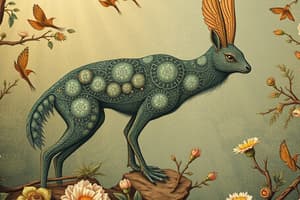Podcast
Questions and Answers
What is the process by which animals slow down their bodily functions to survive winter conditions?
What is the process by which animals slow down their bodily functions to survive winter conditions?
- Estivate
- Hibernate (correct)
- Migrate
- Adapt
Which of the following describes the process of plants breaking down chlorophyll during autumn?
Which of the following describes the process of plants breaking down chlorophyll during autumn?
- Chlorosis
- Deciduousness (correct)
- Photosynthesis
- Dormancy
What adaptation do large animals typically exhibit to find food during winter months?
What adaptation do large animals typically exhibit to find food during winter months?
- Hibernation
- Pollination
- Dormancy
- Migration (correct)
What happens to plants when there is no chlorophyll during winter?
What happens to plants when there is no chlorophyll during winter?
What adaptation is exemplified by humans wearing heavy clothing during winter?
What adaptation is exemplified by humans wearing heavy clothing during winter?
Flashcards are hidden until you start studying
Study Notes
Adaptation: Overview
- Adaptation involves changes to acclimate to new environments or situations.
Human Adaptation
- During winter, humans wear heavier clothing to maintain body warmth.
Plant Adaptation
- Chlorophyll, the green pigment in leaves, is essential for photosynthesis (food production).
- In autumn, shorter days and reduced sunlight lead to the breakdown of chlorophyll, causing leaves to change color (yellow, red, brown) and eventually fall off.
- During winter, the lack of chlorophyll results in dormancy, where plants become inactive.
- Plants re-emerge from dormancy in spring and summer, becoming active again.
Animal Adaptation
- Animals face food scarcity in winter and adapt through two primary strategies:
- Hibernation: Long-term state of reduced metabolic activity characterized by slow heart rate and breathing. Example species include bears and mice.
- Migration: Movement of large animals to different locations to access food or warmer climates during colder months.
Studying That Suits You
Use AI to generate personalized quizzes and flashcards to suit your learning preferences.





